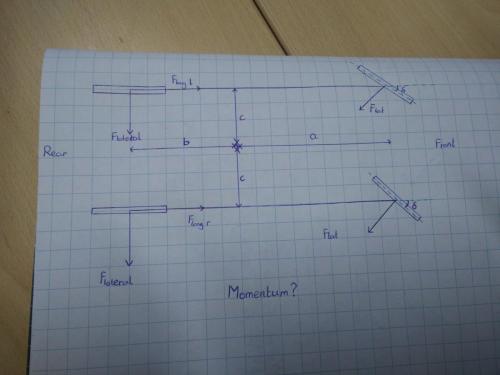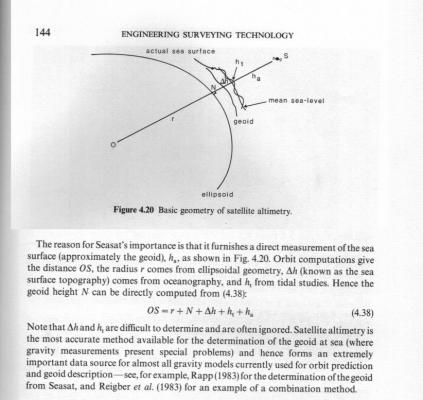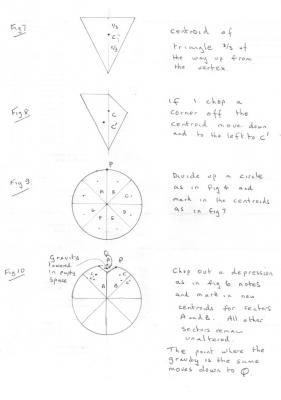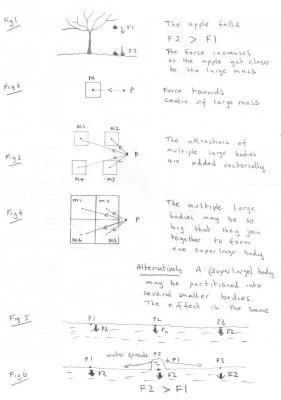-
Posts
18270 -
Joined
-
Last visited
-
Days Won
104
Content Type
Profiles
Forums
Events
Everything posted by studiot
-
You are right in observing that a one dimensional being might have more difficulty in conceiving of more dimensions than, say, a two dimensional being. This would be because a 2D being has two dimensions to compare. The obvious conclusion from this, since we only know of one single time dimension, is that we are in the same position in respect of time. We could also be in the same position in another way since if there were two (or more) beings in the one dimensional world they would be unable to pass each other, but two dimensional beings could do so easily since they could use the extra dimension to go around each other. So we could also be in the same position in respect of travel in time. But this is all speculation so I expect the moderators will move this thread to the speculations section where it belongs.
-
He already did Consider standard traffic lights The 'state vector' cycles, but the lights do not go anywhere.
-
Are you referring to H.A. Lorenz, The Theory of Electrons, Leipzig, 1916 ? As I understand it this was introduced to modify earlier aether theories which foundered at the experimental fact that refractive index depends upon frequency. The Lorenz rest frame was an inertial system in which the aether was at rest.
-
Thank you swansont for your continued lucid explanation. +1 It puts me in mind of something. I recently installed the first of a new generation of laser printers for someone. Lasers suitable for printer duty were once bulky and expensive to buy so the photocopier or printer contained a moving head incorporating that one expensive part and mechanically tracked or scanned it along a guide. Technology has moved on and laser units are now cheap and miniaturised. The latest printers have replaced the scanning head with a row of microlasers and the scanning is performed electronically, activating them in sequence without moving parts.
-
Another way to look at it is that force is the rate of change of momentum. http://www.bbc.co.uk/schools/gcsebitesize/science/add_ocr_pre_2011/explaining_motion/forcesandmotionrev4.shtml
-
We seem to be short of a radius.
-
Good morning, Toby and welcome. Your photo looks much better the correct way up. I am not sure what you are trying to achieve so please explain further. Momentum is a vector that can be resolved into components parallel to the motion and at right angles to it (tangentially and radially) in this case. The tangential momentum is another word for the (instantaneous) linear momentum. Then there is the angular momentum. So over to you?
-
I prefer ajb's way of putting it But Minkowski and relativity only address part of the story. The do not address granularity v continuity , stochastic processes, scale invariance, nor do they form a complete set when assembling the constitutive relations and the conditions of compatibility. Please ask if I have used any unfamiliar terms here.
-

Questions about the geoid (Split from Lake Balaton thread)
studiot replied to michel123456's topic in Earth Science
Isn't that exactly what this says? Except that I did say "in miniature" so the topography would not be the same, the figures quoted imply a scale reduction factor of 500 : 1 [/edit] I have said before that the geoid, though an interesting discussion, is a red herring for the purposes of this thread which is about the actual surface shape of Lake Balaton. I therefore propose that global geoid discussion should be hived off to another thread. To provide a starter for this here is an extract from Mordred's link about the geoid https://en.m.wikipedia.org/wiki/Geoid Now my question is If the Earth were perfectly spherical, homogeneous and isotropic, what would be the shape of the geoid? -

Questions about the geoid (Split from Lake Balaton thread)
studiot replied to michel123456's topic in Earth Science
Sigh. I am sorry Michel, I'm quite sure you have better reasoning powers than this, all I am trying to do is develop an explanation. If you can genuinely contribute, so much the better. But you seem to have entered 'skim and query mode', dashing off stuff and trying to find fault without proper thought. If you read my posts properly you would find better than 'peer reviewed paper' references. Meanwhile you have posted some pretty pictures, from an august organisation that I have no doubt are the most correct to date. But do you understand them? I have asked several times for your explanation of what they mean and what their relevance is to this thread, without any satisfactory answer. I was preparing a some sketches to help you understand gravitational potential equipotential and the geoid, but since you don't seem interested in understanding I don't see the point of continuing. Edit Thanks , Mordred, for the link. It seems to largely coincide with what I am saying, although there are one or two flaky pieces of explanation, which is why consideration of the geoid so often leads to misunderstanding. -

Questions about the geoid (Split from Lake Balaton thread)
studiot replied to michel123456's topic in Earth Science
I said at the beginning of my last big post (post#205) I wanted to go through the geometry first because it is that which causes the greatest confusion. This is because we have both real world measurements and theoretical constructs and models, some of which are extremely sophisticated. It is my view that most of this sophistication is an unnecessary impediment to the aims of this project. This should be set out clearly in the statement of aims I have repeatedly called for. For interest here is the geometry and mathematics of satellite altimetry extracted from Engineering Surveying Technology, edited by Kennie and Petrie, in the section written by P. Cross, Professor of Surveying at Newcastle University You will note the multiple 'correction factors' between the real world and the artificial constructs. -
Thank you swansont for telling us this, I didn't realise my theoretical heath-robinson atom counting clock had been developed and was actually in service. +1
-
Good morning tampitump, your membership here has had a somewhat volatile ride so far so I am going to say +1 for encouragement following a well measured post. In particular the quoted sentence. On the OP question I would observe that the distinction is less than you might imagine, particularly in the american system. Scientists do engineering (swansont is a scientist) and engineers discover things (Heaviside was an engineer.) Science & engineering can also provide the basis for other careers. (Mrs Thatcher was a chemist, John Polkinghorne was a particle physicist.....)
-
I seem to remember a recent post about black sheep, (was it the jokes thread?) Well here are some orange ones. http://www.bbc.co.uk/news/video_and_audio/headlines/37462464 I would embed the video if I knew how.
-

Questions about the geoid (Split from Lake Balaton thread)
studiot replied to michel123456's topic in Earth Science
Deviation of what from where? You don't measure force in metres, let alone hundreds of metres. For your information, my calculations estimate a 15 - 20mm depression in the centre of the lake. By this I mean that a well set up leveling instrument, leveling between the shores in a double run and closure would detect a depression of this relative to the facing shores. Real measurements in the real world. -

Questions about the geoid (Split from Lake Balaton thread)
studiot replied to michel123456's topic in Earth Science
Would you like to explain what this means and how I would relate this to the actual force of gravity on a test mass of 1kg at an actual distance r from the centre of the Earth? -

Questions about the geoid (Split from Lake Balaton thread)
studiot replied to michel123456's topic in Earth Science
As I said it depends upon your map but I could not find a map on the webpage you linked to. Have you given any consideration to the difference between the force due to gravity which becomes numerically greater, the closer you are to the centre of the Earth and the gravitational potential which becomes numerically greater the further away you are from the centre of the Earth. That is potentials start at negative infinity at the centre increase with distance towards zero at infinite distance? Which one of these was plotted on your map (can you not post it here ?) -

Questions about the geoid (Split from Lake Balaton thread)
studiot replied to michel123456's topic in Earth Science
I hope that this response has simply suffered from overhaste. I simply do not understand it. -

Questions about the geoid (Split from Lake Balaton thread)
studiot replied to michel123456's topic in Earth Science
The situation is controlled by both geophysical and geometric factors. My original aim in reviewing the hydraulics was to present only sufficient of the geophysical side to make an assessment of the task and then to work through the geometrical side from the very simple to a stage adequate to meet the project aims. Unfortunately in my haste this geophysical assessment was poorly worded so thank you very much for pointing this out. I see that my words could easily be taken to imply absolute values, when I really meant the change due to some influence. So better phrasing would be "An ocean floor feature 1km high results in a change in surface depression, reducing it by 2 metres." instead of "An ocean floor feature 1km high results in a surface depression of 2 metres." In response to your specific questions 1) The force of gravity is the resultant of the attraction of the whole of the earth, not just part of it. Oceanic crust is indeed thinner than continental crust, but it is also denser so you need less of it to create the same mass. However see my long answer to your question (2), since they are linked. 2) This question is basically : What are the mechanics of the water surface? Well the water surface largely controlled by gravity, which is a force (Newtonian mechanics is just fine for this). So let us start with Newton, his apple and my Fig1. Here the important points are that bodies are subject to a downward force called gravity and those that are free to move move in the direction of increasing force, which is towards the centre of the large body. These points are absolutely vital to the development of the argument. Fig 2 is basically asserting that force has a direction as well as a magnitude and shows how to obtain this direction. This is also important because we call the line between out test point P and the large mass exerting the gravity, the vertical at P. Fig 3 shows that if we have an assembly of large bodies each exerts its own force of gravity as in fig 2 ( just as if the others were not there) and the unique resultant can be found by combining each individual pull vectorially. If we let the large bodies coalesce to form a single body as in Fig 4 the effect is still as if they were separate, but the important point is that we could equally consider dividing up a super large body into conjoined smaller ones. So armed with these principles, let us examine a water surface. Fig 5 shows a water surface where the force of gravity is identical (I have labelled this force as F2) all along, but particularly at points P1, P2 and P3. This is largely for reference. More exciting things happen in Fig 6 if we introduce a hump at P2, so the surface at P2 is now above P1 and P3. Since the surface at P2 is now higher the force of gravity must be lower as stated in Fig1 and labelled F1. Now it is also stated in Fig 1 that a body free to move will move towards a point of greater force of gravity. The space immediately below the hump is still subject to the higher force of gravity F2. But the hump of water is not free to move down as that space is already occupied. But it can move sideways towards P1 and P3, which are also subject to the higher force of gravity F2. So the water spreads out until all the water surface is again at the same force of gravity. It is important to note that a dip in surface would fill in by the opposite reasoning. I have not shown this specifically. But now we must consider what happens if something happens to change the force of gravity at P2 In Fig 7 I have shown, for convenience, the position of point in a triangle towards which the force of gravity is directed and in Fig 8 what happens if we slice of a part of the triangle. Both will be needed in what is to follow. In Fig 9 I have divided a circle up into triangular sectors in the manner of Fig 4. By symmetry the force of gravity at any point P on the circumference is the same, when calculated in the manner of Fig 4. But if we create a depression in the circumference by truncating two sectors, A and B, in the manner of Fig 8 then the situation changes, as shown in Fig 10. In particular the centres of gravity of the individual sectors A and B move towards the centre of the circle and further from the circumference. So by figs 1 and 2 the force of gravity at point P on the circumference is reduced. So by the discussion in Figs 5 and 6 the water surface will dip below the circumference to the point Q where the force of gravity is the same as on the rest of the perimeter. This explains how and why the water surface of the ocean dips down below the geometrical line and that dip is reduced by undersea ridges and seamounts. Notice that I have not needed to introduce artificially devised surfaces such as the geoid etc. Simple mechanics is enough. -
I see you have just joined - Welcome A good start. +1
-
Good morning Michel. I don't quite follow this. You seem to have your insertion process the wrong way round. But to answer the rest of your question, The equation y = Asin(bx) means that if you assign any value to x you can calculate a value for y. That is what is meant by 'for any given value of x'. Now the rest of my point means that your calculation of y will result in the same number whatever time you perform or plot this calculation, because the result does not change with time. You cannot insert a value for time into an equation where it does not explicitly appear. This is true of any equation so that for instance in the equation x2 + y2 + z2 = r2 you cannot insert values for say v or w since they do not appear in the equation. FYI I need to prepare a few sketches to answer your query about gravity in the other thread today, so look there again later.
-
Hello Michel, An equation of a travelling wave is y = Asin (bx-ct), (there are others) A, b and c are constants t is time. Note that it contains both x and t. so if you choose some value for x, the value for y will also depend on t. That is the value of y will be different for different values of t at the same x. The equation I gave before does not contain t y = Asin(bx) So for any given value of x, the value of y will always be the same, whether t is 1 femtosecond, 1 year or 1 millenium. This is the difference I meant.





